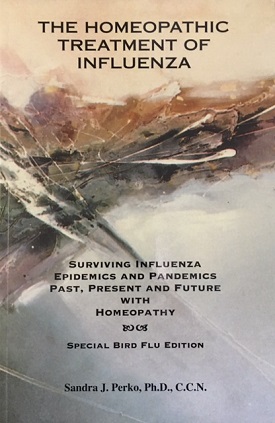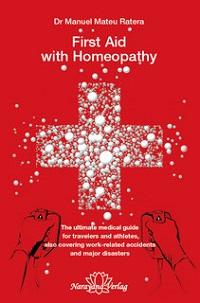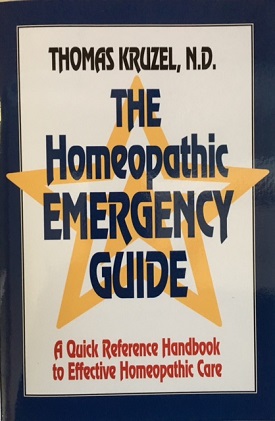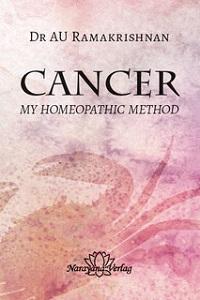The Homeopathic Treatment of Influenza by SANDRA PERKO, PhD [#PERINF]
$39.95
Description
A detailed book on the history and present-day treatment.
[from the back cover]
A History of Influenza Epidemics and Pandemics and How to Survive Them with Homeopathy.
In the fall of the year 1918 the whole world witnessed the most devastating influenza plague to ever befall mankind. The Spanish Influenza pandemic of 1918-1919 is called “one of the three most destructive outbreaks of disease the human race has ever known,” and rivals the Plague of Justinian of 542 A.D., and the Bubonic Plague of 1347-1350. While it took a full four years for the fourteenth-century Bubonic Plague to spread across Europe, and then throughout Asia, the 1918 Spanish Flu circled the globe in little more than four short months. In so doing it took the lives of 20 to 50 million people worldwide, and it sickened fifty times that number.
Public health officials are quietly preparing for the return of a global influenza supervirus which, due to the fact that medicine has squandered its antibiotic arsenal, threatens to eclipse the greatest influenza epidemic of all time. In the words of concerned scientists, “Sooner or later, severe pandemic influenza will once again ravage the world. What will happen when it returns?” “Can such an epidemic or pandemic happen again? The consensus is ‘almost certainly yes.'”
Read how the doctors of Homeopathy treated hundreds of Spanish influenza patients in 1918-1919 and had an extremely low mortality rate.
Learn how to protect yourself and your family with homeopathy.
A detailed discussion of 68 homeopathic remedies historically used in the treatment of influenza and the complications of flu by homeopaths, past and present, for the last 150 years.
A 103-page Quick Keynote Reference which helps speed the process of finding the correct homeopathic remedy for influenza, as well as the common cold, in the shortest possible time.
[From Homeopathy Today]
This book review is reprinted with the permission of the National Center for Homeopathy
The Homeopathic Treatment of Influenza, surviving influenza epidemics and pandemics past, present and future with homeopathy
By Sandra J. Perko, PhD, CCN
Reviewed by Maria T Bohle
Influenza. What is the big deal? If my attitude before I read this book was typical of today’s thinking, we have been lulled into a false sense of security Imagine a disease so virulent that a strong, healthy young man in the prime of his life gets a sore throat in the morning, presents himself to a clinic because he is feeling slightly “out of sorts,” and is dead by evening. Or, a “healthy” person boards a bus or train and is dead before reaching his destination. Now, multiply these true stories by thousands of cases and we have a small insight into what happened during the influenza pandemic of 1918, a pandemic that may have been responsible for 50 to 100 million deaths.
Wow! If a lethal flu hit my home town would I (as a fairly new homeopath) be ready for it? I am sure homeopathy could help, but would my skills be up to handling something like that? How about my family and friends who live hundreds of miles away? Is there information I could send them that would help them in a flu crisis situation? Information that could help them find the right remedy to use to save their lives?
Yes, yes, yes. Sandra Perko’s book, The Homeopathic Treatment of Influenza, surviving influenza epidemics and pandemics past, present and future with homeopathy, is a treasure. The book is easy to read and easy to understand whether you are an experienced homeopath or just an interested reader. Best of all, with even limited knowledge of homeopathy, this book can stand alone as a source of information and aid to successful prescribing.
The first section of The Homeopathic Treatment of Influenza is de voted to the history of influenza. We are treated to a well-documented literature search of historical records, newspapers, and recorded accounts of the flu as it was happening. Perko pays special attention to the symptoms, how those symptoms manifested, and treatment protocols-information of critical importance to the homeopath-yet information still quite interesting to the lay read The author includes flu complications, the symptoms of pneumo nia, mortality figures, and autopsy results. She defines the neces sary terms so we can all understand them when used in context. For instance there is a section that defines and describes the differ ent kinds of fevers: hectic, intermittent, etc.
We also learn about treatment options (e.g., rest and diet), dangers of high fevers, what to look for, etc. There is a list of herbs that can be used to help with fever control (herbal teas) and hydrotherapy. This is all in the first 133 pages.
The rest of the book is indeed devoted to the homeopathic treatment of influenza. Homeopathic medicine had an impressive success record treating the flu. And Sandra Perko makes that information available to anyone who will take the time to read this book.
There is a Repertory Section that is easy to use. Did the flu come on fast or slow? You will find a convenient list of remedies to help narrow down your selection. Then find the “main complaint” of the person with influenza-is it nausea, headache, high fever, eye symptoms, bone symptoms, etc.? After each “main complaint” is a list of the most used homeopathic remedies along with their keynotes, Write down the most indicated remedies and move to the next dominant symptom easy enough, even for our non- homeopathically minded relatives.
Once you are finished with the narrowing process you can confirm your remedy choice with the Influenza Materia Medica. This is one of the nicest features of the book, over 220 pages, where remedies are presented in alphabetical order. This is where you ca refine your choices to a single remedy.
At this point in the remedy selection process I would typically reach for the materia medicae of Burnett, Gibson, Blackie, etc.-but she does it for us in the most wonderful detail with actual quotes from an impressive list of some of the century’s homeopathic greats-which helps to elucidate the characteristics of the remedies and bring them to life.
For example, under Rhus tox there is a half-page of keynotes, followed by quotes from Borland, Castro, Dewey, Farrington, Jouann, Kruzel, Lilienthal, Morrison, and Nash.
In my opinion, this is a most valuable book that would appeal practitioners, interested home-homeopaths, students, and scholar,, Perko has very credibly supported homeopathic theory and prac tice and made it understandable, as well as introduced us to man, capable and competent homeopathic authors of books that the average lay person would not have on their library shelves.
When the flu hits, this is a book that you will want in hand. I wouldn’t be without it!
The 2009 Swine Flu Pandemic
As we near, what is hoped to be, the end of the current “Swine Flu” pandemic, we are left with the uncomfortable problematic predicament that we may not have seen the last of H1N1. Why is that? We know that the infamous Spanish Flu of 1918-1919 came in three waves. As explained on page 18 of The Homeopathic Treatment of Influenza, Surviving Influenza Epidemics and Pandemics Past, Present and Future with Homeopathy, “Ordinary influenza epidemics are more common during the cold winter months.
Therefore, even though the first wave of the disease began in the spring months of March, April and May of 1918, and produced an unanticipated higher than normal mortality rate, and even though in the back of their
minds, doctors were aware that influenza pandemics were known to appear outside of the winter months, very little thought was given to this ominous sign.”That is, until the second wave appeared. “The second and most lethal form of the disease struck in the late summer of 1918 and continued through the following fall and winter. It proved to be the most devastating influenza event in medical history. . . . During the six months of the second wave there was such an astonishing loss of life, one that was so great as to be unprecedented in 20th century medical history for any previous disease, that it seemed the whole world was dying. Hardly a household escaped the death of at least one family member and thousands of children were orphaned.”
“Just as the epidemic appeared to subside somewhat in the spring of 1919 and people began to feel that the worst was over, the Spanish Lady returned again in the winter of 1919 to finish her final death march. . . . .
After she had exacted her fury in what was the worst medical catastrophe of all time (50 to 100 million dead), she vanished from the face of the earth as mysteriously as she had come.”
In the ninety-one years since that unmatched Spanish Flu, virologists throughout the world have been carefully watching and preparing for the appearance of anything approaching the likes of such an influenza
virus. I have chronicled the following major epidemics and pandemics in this book – the Asian Flu, 1957, the Hong Kong Flu, 1968, The Swine Flu, 1976 and the Bird Flu, 1997. While these were bad flu episodes (the CDC reports that 36,000 die each year of complications of influenza) they have not proved to be a match for the Spanish Flu.
What then are we to expect from the current 2009, H1N1 “Swine Flu”? While still quite active in many parts of the world, and despite the numerous deaths from complications, it does appear to be on the decline.
However, the Centers for Disease Control and Prevention, and the World Health Organization are well aware of the Three Waves of Deadly Influenza Pandemics, and are currently working tirelessly to try and stay ahead of the probable return of H1N1 in perhaps a far deadlier second wave mutated form. We certainly cannot afford to become complacent. According to a recent Washing Post article, “Exactly how swine flu fits into the pantheon of flu pandemics won’t be known for a while. It will take months – and many more victims – for its full personality and behavior to emerge. This is a lot more than just seasonal flu out of season. Pandemic flu strains – and this new H1N1strain is all but certain to cause the 21st century’s first pandemic – are unpredictable. Any contagious disease that most of the world’s 6.8 billion people can catch is inherently dangerous.”
It is very important, therefore, to understand that this book is not just a book concerning “Swine Flu.” It is not just a book concerning “Bird Flu.” It is not even just a homeopathic book on Influenza. It is a homeopathic book about how to protect and survive any upper respiratory viral infections, be it influenza, bronchitis, viral pneumonia and even the common viral cold. Why wait until panic grips the world with the appearance of any future flu “super bug.” Practice using the Quick Keynote Reference pages 135 – 233 & 408 – 415. Learn how now to spot the characteristics of the most common flu remedies as they may also apply in lesser cases of viral infections, so that when you, or your family, are forced to deal with a truly dangerous influenza outbreak, you will be ready.






Reviews
There are no reviews yet.